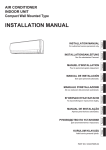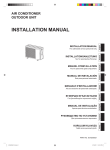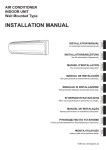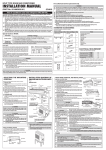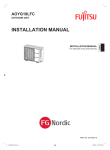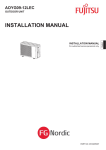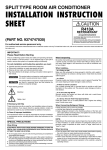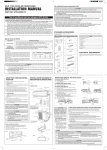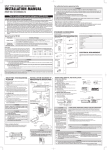Download INSTALLATION MANUAL
Transcript
AIR CONDITIONER OUTDOOR UNIT Solo para personal autorizado. MANUALE D'INSTALLAZIONE Ad uso esclusivo del personale autorizzato. ΕΓΧΕΙΡΙΔΙΟ ΕΓΚΑΤΑΣΤΑΣΗΣ Για εξουσιοδοτημένο προσωπικό σέρβις. MANUAL DE INSTALAÇÃO Apenas para técnicos autorizados. РУКОВОДСТВО ПО УСТАНОВКЕ Для уполномоченного персонала. KURULUM KILAVUZU Yetkili servis personeli içindir. Deutsch Français Español MANUAL DE INSTALACIÓN Italiano Pour le personnel agréé uniquement. EλληvIkά MANUEL D'INSTALLATION Português Nur für autorisiertes Personal. Русский INSTALLATIONSANLEITUNG Türkçe INSTALLATION MANUAL For authorized service personnel only. English INSTALLATION MANUAL PART NO. 9374995202-02 9374995202-02_IM.indb 1 28/11/2555 10:28:08 AIR CONDITIONER OUTDOOR UNIT 2.2. Special tools for R410A Tool name INSTALLATION MANUAL 9374995202-02 Gauge manifold Contents 1. SAFETY PRECAUTIONS .......................................................................................... 1 2. ABOUT THE UNIT ..................................................................................................... 1 3. SELECTING THE MOUNTING POSITION ............................................................... 2 4. INSTALLATION DIAGRAM ........................................................................................ 2 5. INSTALLATION ......................................................................................................... 3 6. PUMP DOWN ............................................................................................................ 6 Contents of change Pressure is high and cannot be measured with a conventional (R22) gauge. To prevent erroneous mixing of other refrigerants, the diameter of each port has been changed. It is recommended the gauge with seals -0.1 to 5.3 MPa (-1 to 53 bar) for high pressure. -0.1 to 3.8 MPa (-1 to 38 bar) for low pressure. Charge hose To increase pressure resistance, the hose material and base size were changed. Vacuum pump A conventional vacuum pump can be used by installing a vacuum pump adapter. Gas leakage detector Special gas leakage detector for HFC refrigerant R410A. Copper pipes It is necessary to use seamless copper pipes and it is desirable that the amount of residual oil is less than 40 mg/10 m. Do not use copper pipes having a collapsed, deformed or discolored portion (especially on the interior surface). Otherwise, the expansion value or capillary tube may become blocked with contaminants. As an air conditioner using R410A incurs pressure higher than when using R22, it is necessary to choose adequate materials. Thicknesses of copper pipes used with R410A are as shown in Table1. Never use copper pipes thinner than 0.8 mm even when it is available on the market. 1. SAFETY PRECAUTIONS 1.1. For authorized service personnel only CONNECTION PIPE REQUIREMENT WARNING This mark indicates procedures which, if improperly performed, might lead to the death or serious injury of the user. For the room air conditioner to operate satisfactory, install it as outlined in this installation manual. Connect the indoor unit and outdoor unit with the air conditioner piping and cables available standards parts. This installation manual describes the correct connections using the standard accessories and the parts specified in this installation manual. Have installation work done by authorized service personnel only. Do not turn on the power until all installation work is complete. This mark indicates procedures which, if improperly performed, might possibly result in personal harm to the user, or damage to property. When installing pipes shorter than 3 m, sound of the outdoor unit will be transferred to the indoor unit, which will cause large operating sound or some abnormal sound. This installation manual describes how to install the outdoor unit only. To install the indoor unit, refer to the installation manual included with the indoor unit. • Be careful not to scratch the air conditioner when handling it. • After installation, explain correct operation to the customer, using the operating manual. • Let the customer keep this installation manual because it is used when the air conditioner is serviced or moved. • The maximum lengths of this product are shown in the following table. If the units are further apart than this, correct operation cannot be guaranteed. Model type 30L Pipe diameter Liquid Gas 9.52 mm 15.88 mm (3/8 in.) (5/8 in.) Piping length Outer diameter Thickness 3/8 in 5/8 in 9.52 mm 15.88 mm 0.8 mm 1.0 mm WARNING Do not use the existing (for R22) piping and flare nuts. If the existing materials are used, the pressure inside the refrigerant cycle will rise and cause failure, injury, etc. (Use the special R410A materials.) Do not use this equipment with air or any other unspecified refrigerant in the refrigerant lines. Excess pressure can cause a rupture. Do not use an extension cable. CAUTION Nominal diameter MAX. MIN. Max. height difference (Indoor unit to outdoor unit) 50 m 5m 30 m 2. ABOUT THE UNIT 2.1. Precautions for using R410A refrigerant The basic installation work procedures are the same as conventional refrigerant (R22) models. However, pay careful attention to the following points: Since the working pressure is 1.6 times higher than that of conventional refrigerant (R22) models, some of the piping and installation and service tools are special. (See the table below.) Especially, when replacing a conventional refrigerant (R22) model with a new refrigerant R410A model, always replace the conventional piping and flare nuts with the R410A piping and flare nuts. Models that use refrigerant R410A have a different charging port thread diameter to prevent erroneous charging with conventional refrigerant (R22) and for safety. Therefore, check beforehand. [The charging port thread diameter for R410A is 1/2 inch.] During installation, make sure that the refrigerant pipe is attached firmly before you run the compressor. Do not operate the compressor under the condition of refrigerant piping not attached properly with 2-way or 3-way valve open. This may cause abnormal pressure in the refrigeration cycle that leads to rupture and even injury. When installing and relocating the air conditioner, do not mix gases other than the specified refrigerant (R410A) to enter the refrigerant cycle. If air or other gas enters the refrigerant cycle, the pressure inside the cycle will rise to an abnormally high value and cause rupture, injury, etc. 2.3. Power • The rated voltage 230V AC 50Hz. WARNING The rated voltage of this product is 230 V AC 50 Hz. Before turning on the power, check if the voltage is within the 220 V -10 % to 240 V +10 % range. Always use a special branch circuit and install a special receptacle to supply power to the room air conditioner. Use a circuit breaker and receptacle matched to the capacity of the air conditioner. Do not extend the power cable. Perform wiring work in accordance with standards so that the air conditioner can be operated safely and positively. Install a leakage circuit breaker in accordance with the related laws and regulations and electric company standards. The circuit breaker is installed in the permanent wiring. Always use a circuit that can trip all the poles of the wiring and has an isolation distance of at least 3 mm between the contacts of each pole. CAUTION Be more careful that foreign matter (oil, water, etc.) does not enter the piping than with refrigerant (R22) models. Also, when storing the piping, securely seal the opening by pinching, taping, etc. The power source capacity must be the sum of the air conditioner current and the current of other electrical appliances. When the current contracted capacity is insufficient, change the contracted capacity. When charging the refrigerant, take into account the slight change in the composition of the gas and liquid phases. And always charge from the liquid phase where refrigerant composition is stable. When the voltage is low and the air conditioner is difficult to start, contact the power company the voltage raised. En-1 9374995202-02_IM.indb 1 28/11/2555 10:28:09 2.4. Electric requirement 3. SELECTING THE MOUNTING POSITION • Electric wire size and fuse capacity: • Decide the mounting position with the customer as follows: MAX. MIN. MAX. MIN. Power supply cable (mm2) Connection cable (mm2) 4.0 3.5 2.5 1.5 Fuse capacity (A) • Do not set to a place where there is oily smoke, oil is used in the factory, the unit can contact sea breeze, sulfide gases will be generated in the hot spring area, corrosive gases will be generated, animal may urine on the unit and ammonia will be generated and a dusty place. 30 3.1. Outdoor unit • Use conformed cable with Type245 IEC57. • Install all electrical works in accordance to the national standard. • Install the disconnect device with a contact gap of at least 3 mm in all poles nearby the units. (Both indoor unit and outdoor unit) • Install the circuit breaker nearby the units. 2.5. Operating range Outdoor Temperature Cooling / Dry Mode About -10 to 46 °C Heating Mode About -15 to 24 °C 2.6. Additional charge Refrigerant suitable for a piping length of 20 m is charged in the outdoor unit at the factory. When the piping is longer than 20 m, additional charging is necessary. For the additional amount, see the table below. Piping length Model type 30L (1) If possible, do not install the unit where it will be exposed to direct sunlight. (If necessary, Install a blind that does not interfere with the air flow.) (2) Do not install the unit where a strong wind blows or where it is very dusty. (3) Do not install the unit where people pass. (4) Take you neighbors into consideration so that they are not disturbed by air blowing into their windows or by noise. (5) Provide the space shown in figure so that the airflow is not blocked. Also for efficient operation, leave open three of the four directions front, rear, and both sides. (6) Install the outdoor unit in a location which can withstand the weight of the unit and vibration, and which can install horizontally. (7) Provide the indicated space to ensure good airflow. (8) During heating operation, drain water flows from the outdoor unit. Therefore, install the outdoor unit in a place where the drain water flow will not be obstructed. (Reverse cycle model only) (9) Install the outdoor unit in a place where it will be free from being dirty or getting wet by rain as much as possible. (10) Install the unit where connection to the indoor unit is easy. WARNING 20 m 30 m 40 m 50 m Rate None 400 g 800 g 1200 g 40 g/m Install at a place that can withstand the weight of the outdoor units and install positively so that the units will not topple or fall. CAUTION CAUTION When moving and installing the air conditioner, do not mix gas other than the specified refrigerant R410A inside the refrigerant cycle. When charging the refrigerant R410A, always use an electronic balance for refrigerant charging (to measure the refrigerant by weight). When charging the refrigerant, take into account the slight change in the composition of the gas and liquid phases, and always charge from the liquid phase side whose composition is stable. Gas Do not install where there is the danger of combustible gas leakage. Do not install near heat sources. If children under 10 years old may approach the unit, take preventive measures so that they cannot reach the unit. 4. INSTALLATION DIAGRAM [OUTDOOR UNIT] • Do not directly install it on the ground, otherwise it will cause failure. R410A Liquid Add refrigerant from the charging valve after the completion of the work. If the units are further apart than the maximum pipe length, correct operation cannot be guaranteed. 2.7. Accessories Name and Shape Q’ty Insulation (seal) Name and Shape Q’ty Installation manual 1 1 5 cm or more Drain cap Drain pipe 1 CAUTION 2 In the area with heavy snowfall, if the intake and outlet of outdoor unit is blocked with snow, it might become difficult to get warm and it is likely to cause of the breakdown. Please construct a canopy and a pedestal or place the unit on a high stand (local configured). One set of following parts are necessary in installation of this air conditioner. Name Connection pipe assembly Connection cable Wall pipe Decorative tape Vinyl tape Wall cap Saddle Drain hose Tapping screws Sealant M10 bolt, nut En-2 9374995202-02_IM.indb 2 28/11/2555 10:28:09 (3) Since the drain water flows out of the outdoor unit during heating operation, install the drain pipe and connect it to a commercial 16 mm hose. When installing the drain pipe, plug all the holes other than the drain pipe mounting hole in the bottom of the outdoor unit with putty so there is no water leakage. (Reverse cycle model only) When there are obstacles at the back side. 370 mm Drain cap mounting holes Bottom side 10 cm or more 650 mm When there are obstacles at the back and front sides. Drain pipe mounting hole 4-ø12 hole Base Drain pipe 10 cm or more 60 cm or more CAUTION When the outdoor temperature is 0 °C or less, do not use the accessory drain pipe and drain cap. If the drain pipe and drain cap are used, the drain water in the pipe may freeze in extremely cold weather. (Reverse cycle model only) When there are obstacles at the back, side(s), and top. 5.2. Outdoor unit wiring 60 cm or more WARNING Use crimp-type terminals and tighten the terminal screws to the specified torques, otherwise, abnormal overheating may be produced and possibly cause heavy damage inside the unit. Match the terminal block numbers and connection cable colors with those of the outdoor unit. Erroneous wiring may cause burning of the electric parts. Connect the connection cable firmly to the terminal block. Imperfect installation may cause a fire. 10 cm or more 30 cm or more 25 cm or more (Service space) When there are obstacles at the back side with the installation of more than one unit. Always fasten the outside covering of the connection cable with the cable clamp. (If the insulator is chafed, electric leakage may occur.) Securely earth the power cable plug. Do not use the earth screw for an external connector. Only use for interconnection between two units. HOW TO CONNECT THE WIRE TO THE TERMINALS (1) Use crimp-type terminals with insulating sleeves as shown in the figure below to connect to the terminal block. (2) Securely crimp the crimp-type terminals to the wires using an appropriate tool so that the wires do not come loose. (3) Use the specified wires, connect them securely, and fasten them so that there is no stress placed on the terminals. (4) Use an appropriate screwdriver to tighten the terminal screws. Do not use a screwdriver that is too small, otherwise, the screw heads may be damaged and prevent the screws from being properly tightened. 25 cm or more 30 cm or more 25 cm or more (5) Do not tighten the terminal screws too much, otherwise, the screws may break. (6) See the table below for the terminal screw tightening torques. Crimp-type terminal Strip 10 mm 5. INSTALLATION Sleeve 5.1. Installation (1) Outdoor unit to be fasten with bolts at the four places indicated by the arrows without fail. (2) Fix securely with bolts on a solid block. (Use 4 sets of commercially available M10 bolt, nut and washer.) Bolt Nut Screw with special washer Wire Crimp-type terminal Terminal board Block Terminal block Screw with special washer Crimp-type terminal Wire En-3 9374995202-02_IM.indb 3 28/11/2555 10:28:09 Tightening torque M4 screw 1.2 to 1.8 N·m (12 to 18 kgf·cm) M5 screw 2.0 to 3.0 N·m (20 to 30 kgf·cm) 1. CONNECTION DIAGRAMS Connection cable Power supply EARTH Power supply cable EARTH 3 2 1 N L 3 2 1 Indoor unit side terminal Outdoor unit side terminal Power line Indoor unit (5) Power supply cable and connection cable should be fixed with cable clip as shown in the figure. Fill in a gap at the entrance of the cables with insulation (seal). EARTH Power supply cable and connection cable 2. CONNECTION CABLE PREPARATION Keep the earth wire longer than the other wires. 30 mm or more Cable clip Power supply cable or connection cable Earth wire Insulation (Seal) 40 mm or more CAUTION CAUTION When connecting the power supply cable, make sure that the phase of the power supply matches with the phase of the terminal board. If the phases do not match, the compressor will rotate in reverse and will not be able to compress. Fix cables so that cables do not make contact with the pipes (especially on high pressure side). Do not make power supply cable and connection cable come in contact with valve (Gas). Power supply cable and connection cable Gap (1) Service cover removal • Remove the two mounting screws. • Remove the service cover by pushing downwards. Valve (Gas) Hook (3 places) Direction of the service cover removal (6) Put the service cover and valve cover back after completion of the work. 5.3. Connecting the piping Service cover (2) Valve cover removal. • Remove the one mounting screw. • Remove the valve cover by sliding upward. Valve cover FLARING (1) Cut the connection pipe to the necessary length with a pipe cutter. (2) Hold the pipe downward so that cuttings will not enter the pipe and remove the burrs. (3) Insert the flare nut onto the pipe and flare the pipe with a flaring tool. Insert the flare nut (always use the flare nut attached to the indoor and outdoor units respectively) onto the pipe and perform the flare processing with a flare tool. Use the special R410A flare tool, or the conventional (for R22) flare tool. When using the conventional flare tool, always use an allowance adjustment gauge and secure the A dimension shown in table 2. Check if [L] is flared uniformly and is not cracked or scratched. Hook (4 places) Die (3) Connect the power supply cable and the connection cable to terminal. (4) Fasten the power supply cable and connection cable with cable clamp. A Control box Pipe Terminal blocks Pipe outside diameter Cable clamp Firmly secure cable clamp so wire terminations will not receive external stress. Cable clamp ø 9.52 mm (3/8") ø 15.88 mm (5/8") Flaring tool for R410A, clutch type 0 to 0.5 0 to 0.5 A (mm) Conventional (R22) Flaring tool Clutch type Wing nut type 1.0 to 1.5 1.5 to 2.0 1.0 to 1.5 1.5 to 2.0 BENDING PIPES Use the specified wire type and connect it securely. (1) When bending the pipe, be careful not to crush it. (2) To prevent breaking of the pipe, avoid sharp bends. Bend the pipe with a radius of curvature of 70 mm or over. (3) If the copper pipe is bend the pipe or pulled to often, it will become stiff. Do not bend the pipes more than three times at one place. En-4 9374995202-02_IM.indb 4 28/11/2555 10:28:09 Connection pipe CONNECTION PIPES Outdoor unit (1) Detach the caps and plugs from the pipes. Blank cap Outdoor unit Hexagon wrench CAUTION Be sure to apply the pipe against the port on the indoor unit and the outdoor unit correctly. If the centering is improper, the flare nut cannot be tightened smoothly. If the flare nut is forced to turn, the threads will be damaged. Use a 4 mm hexagon wrench. 3-way valve Service hose with valve core Charging port Do not remove the flare nut from the indoor unit pipe until immediately before connecting the connection pipe. Cap (2) Centering the pipe against port on the outdoor unit, turn the flare nut with your hand. To prevent gas leakage, coat the flare surface with alkylbenzene oil (HAB). Do not use mineral oil. (3) Tighten the flare nut of the connection pipe at the outdoor unit valve connector. CAUTION Gauge manifold Lo Use a clean gauge manifold and charging hose for R410A exclusively Hi Vacuum pump 3-way valve (Liquid) Flare nut Connection pipe (Liquid) 3-way valve (Gas) Flare nut Connection pipe (Gas) Service hose (4) When the flare nut is tightened properly by your hand, use a torque wrench to finally tighten it. Holding spanner CAUTION Do not purge the air with refrigerants, but use a vacuum pump to vacuum the installation! There is no extra refrigerant in the outdoor unit for air purging! Use a vacuum pump and gauge manifold and charging hose for R410A exclusively. Using the same vacuum for different refrigerants may damage the vacuum pump or the unit. Body side 90° GAS LEAKAGE INSPECTION CAUTION Torque wrench After connecting the piping, check the all joints for gas leakage with gas leak detector. When inspecting gas leakage, always use the vacuum pump for pressure. Do not use nitrogen gas. CAUTION Hold the torque wrench at its grip, keeping it in the right angle with the pipe, in order to tighten the flare nut correctly. Flare nut 9.52 mm (3/8 in.) dia. 15.88 mm (5/8 in.) dia. Tightening torque 32 to 42 N·m (320 to 420 kgf·cm) 63 to 75 N·m (630 to 750 kgf·cm) CAUTION Fasten a flare nut with a torque wrench as instructed in this manual. If fastened too tight, the flare nut may be broken after a long period of time and cause a leakage of refrigerant. CAUTION Install insulation around both the gas and liquid pipes. Failure to do so may cause water leaks. Use insulation with heat resistance above 120 °C. (Reverse cycle model only) In addition, if the humidity level at the installation location of the refrigerant piping is expected to exceed 70%, install insulation around the refrigerant piping. If the expected humidity level is 70-80%, use insulation that is 15 mm or thicker, and if the expected humidity level exceeds 80%, use insulation that is 20 mm or thicker. If insulation is used that is not as thick as specified, condensation may form on the surface of the insulation. In addition, use insulation with heat conductivity of 0.045 W/(m·K) or less (at 20 °C). 5.5. Test run 5.4. Air purge • Perform test operation and check items. Always use a vacuum pump to purge the air. Refrigerant for purging the air is not charged in the outdoor unit at the factory. (1) Remove the cap, and connect the gauge manifold and the vacuum pump to the charging valve by the service hoses. (2) Vacuum the indoor unit and the connection pipes until the pressure gauge indicates -0.1 MPa (-76 cmHg). (3) When -0.1 MPa (-76 cmHg) is reached, operate the vacuum pump for at least 60 minutes. (4) Disconnect the service hoses and fit the cap to the charging valve to the specified torque. (5) Remove the blank caps, and fully open the spindles of the 2-way and 3-way valves with a hexagon wrench [Torque: 6~7 N·m (60 to 70 kgf·cm)]. (6) Tighten the blank caps of the 2-way valve and 3-way valve to the specified torque. 9.52 mm (3/8 in.) Blank cap 15.88 mm (5/8 in.) Charging port cap • For the test operation method, refer to the operating manual. • The outdoor unit, may not operate, depending on the room temperature. In this case, press the test run button on the remote controller while the air conditioner is running. (Point the transmitter section of the remote controller toward the air conditioner and press the test run button with the tip of a ball-point pen, etc.) • To end test operation, press the remote controller START/STOP button. (When the air conditioner is run by pressing the test run button, the OPERATION indicator lamp and TIMER indicator lamp will simultaneously flash slowly.) Transmitter section Tightening torque 20 to 25 N·m (200 to 250 kgf·cm) 30 to 35 N·m (300 to 350 kgf·cm) 12.5 to 16 N·m (125 to 160 kgf·cm) Test run button En-5 9374995202-02_IM.indb 5 28/11/2555 10:28:10 OUTDOOR UNIT (1) Is there any abnormal noise and vibration during operation? (2) Will noise, wind, or drain water from the unit disturb the neighbors? (3) Is there any gas leakage? 5.6. Customer guidance Explain the followings to the customer in accordance with the operating manual: (1) Starting and stopping method, operation switching, temperature adjustment, timer, airflow switching, and other remote controller operations. (2) Air filter removal and cleaning, and how to use the airflow direction louvers. (3) Give the operating and installation manuals to the customer. 6. PUMP DOWN 6.1. Pump down PUMP DOWN OPERATION (FORCED COOLING OPERATION) To avoid discharging refrigerant into the atmosphere at the time of relocation or disposal, recover refrigerant by doing the cooling operation or forced cooling operation according to the following procedure. (When the cooling operation cannot start in winter, and so on, start the forced cooling operation.). (1) Do the air purging of the charge hose by connecting the charging hose of gauge manifold to the charging port of 3-way valve and opening the low-pressure valve slightly. (2) Close the valve stem of 2-way valve completely. (3) Start the cooling operation or following forced cooling operation. Keep on pressing the MANUAL AUTO button of the indoor unit for more than 10 seconds. The operation indicator lamp and timer indicator lamp will begin to flash simultaneously during test run. (The forced cooling operation cannot start if the MANUAL AUTO button is not kept on pressing for more than 10 seconds.) (4) Close the valve stem of 3-way valve when the reading on the compound pressure gage becomes 0.05~0 Mpa (0.5~0 kg/cm2). (5) Stop the operation. • Press the START/STOP button of the remote control unit to stop the operation. • Press the MANUAL AUTO button when stopping the operation from indoor unit side. (It is not necessary to press on keeping for more than 10 seconds.) CAUTION During the pump-down operation, make sure that the compressor is turned off before you remove the refrigerant piping. Do not remove the connection pipe while the compressor is in operation with 2 way or 3 way valve open. This may cause abnormal pressure in the refrigeration cycle that leads to rupture and even injury. En-6 9374995202-02_IM.indb 6 28/11/2555 10:28:10








